
Price: $9,999 / AU$11,499
Screen size: 83 inches
Model: Samsung S95F
Resolution: 3,840x2,160
HDR: HDR10, HDR10+, HLG
Refresh Rate: 165Hz
Ports: 4x HDMI 2.1, 3 x USB-A, 1 x USB-C
Audio: 70W
Smart TV Software: Tizen OS
Size (without stand): 1844.2 x 1056.8 x 12.6mm
Weight (without stand): 85.1 pounds / 38.6kg
Full disclosure: I came into this Samsung S95F OLED TV review with a healthy amount of skepticism. Having reviewed many TVs over the years, I’ve just never totally bought into all the OLED hype.
Sure, its contrast and black levels are unmatched, but OLED's lower brightness levels and potential for burn-in have always put me off. Given the option, I would almost always choose a Mini-LED TV over an OLED.
While last year's S95D OLED TV made some significant strides over its predecessor, Samsung still considered the Mini LED-sporting QN900D Neo QLED 8K TV as its flagship television of 2024. I awarded the QN900D a perfect 5-star rating in my review, so you won't get any arguments from me.
But that was then, and this is now. In 2025, Samsung is unwilling to choose a favorite between the upcoming QN990F Neo QLED 8K TV and the S95F OLED TV I've reviewed here — they're both flagships as far as the South Korean electronics giant is concerned.
Now that I've had some time with the S95F OLED TV, I can see why Samsung is so confident about it: The S95F is Samsung's greatest OLED television to date, improving on its predecessor in every way that counts. Of course, I'll need to see the QN990F for myself before I can confidently crown the S95F my favorite Samsung flagship of 2025.
Samsung S95F OLED TV review: Pricing and availability
Samsung's S95F OLED TV is available in four sizes around the world, though which sizes are available to you will depend on your region. That said, Samsung has not yet announced pricing and availability details for the S95F OLED TV in the UK. More information will be provided as it becomes available.
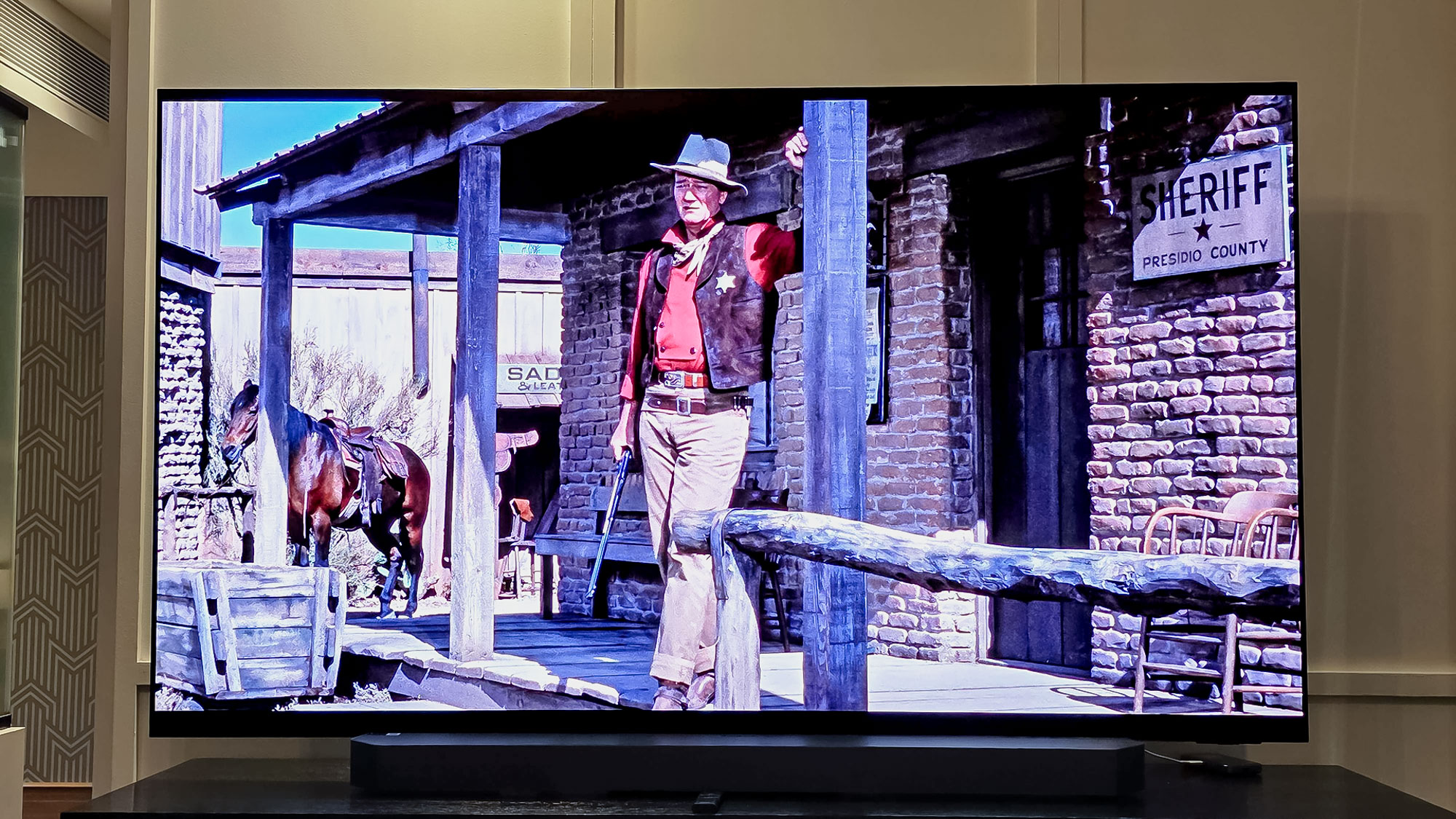
For now, you can find a complete US / AU pricing list for the S95F OLED TV below, along with the best S95F OLED TV deals in your region.
- Samsung S95F (55-inch): $2,300 / N/A
- Samsung S95F (65-inch): $3,300 / AU$5,299
- Samsung S95F (77-inch): $4,500 / AU$7,999
- Samsung S95F (83-inch): N/A / AU$9.999
It's worth mentioning that there's been some contention regarding the panels used in the S95F range, as they can vary depending on size. You will notice that Samsung is not using the term QD-OLED in any of its marketing regarding the S95F, and that's because the new 83-inch model (which isn't currently offered in the US) uses a WOLED panel.
For the purposes of this review, I focused my attention on the 83-inch model, however, I did also have access to the 77-inch version for comparison. I asked Samsung's PR about the different panel technologies used in each television, and was told that Samsung is "not discussing panel technologies" on the S95F, opting instead to focus on the experience offered by the TVs, which I was assured would be the same.
Having watched both the 83-inch and 77-inch models back-to-back, I can indeed say that I found no discernible difference between the two — each television was exceptionally bright, offered excellent color accuracy and featured the same glare-free display. For all intents and purposes, my experience with each model was identical.
Unsure about which TV size is right for you? Our 'What TV size should you buy?' guide can help.
Samsung S95F OLED TV review: Design and remote
Just like the S95D before it, Samsung's new S95F is a beautifully designed television, particularly when viewed from side on — it boasts a uniform depth of just 12.6mm (0.49 inches) on the 83-inch model, and 11mm (0.43 inches) on the 77-inch model, making it an ideal candidate for wall mounting regardless of size option.
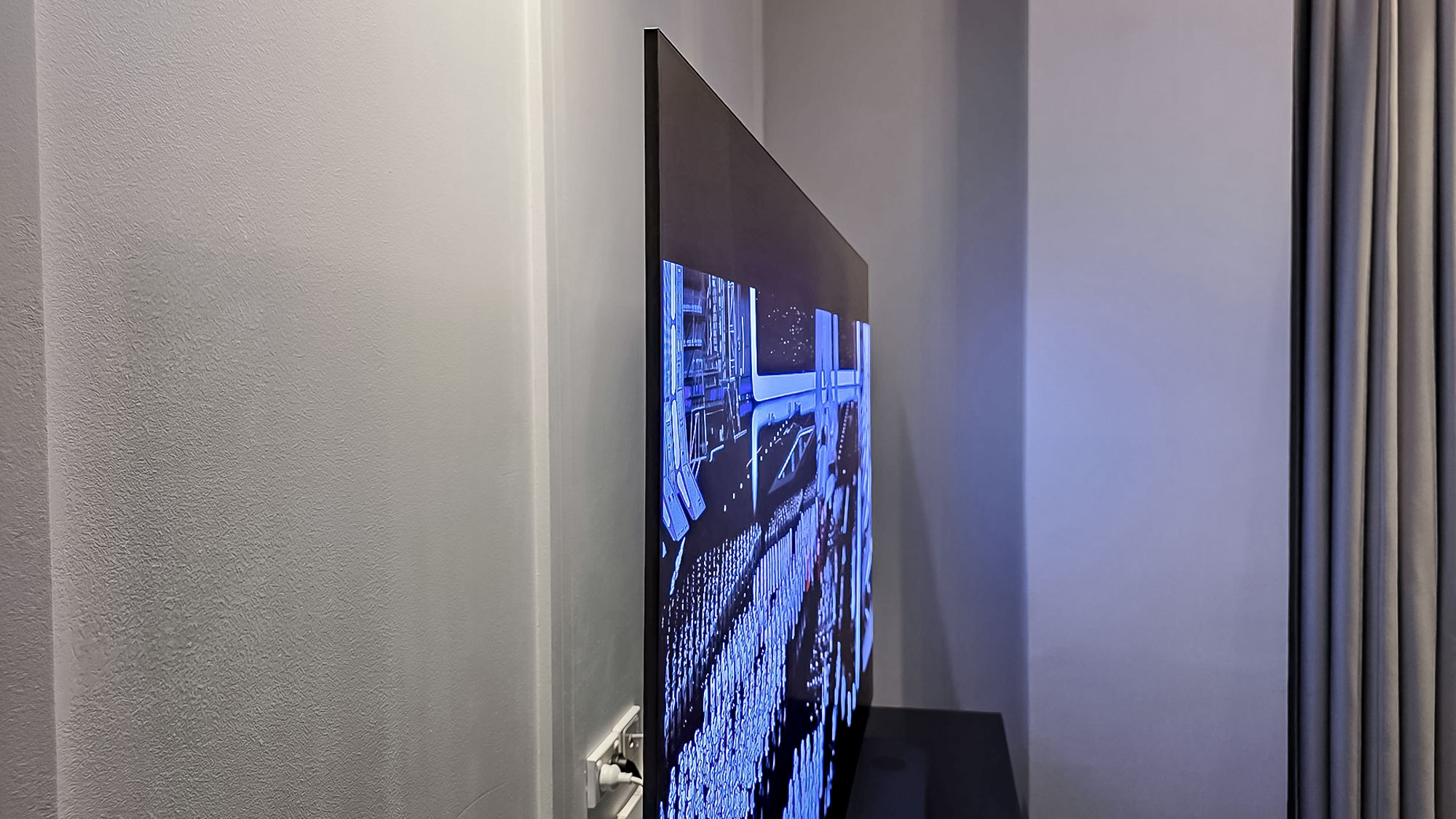
Of course, the reason it's so thin is due to the One Connect Box, which is essentially a detachable media receiver that houses all of the S95F's inputs and serves as its power supply — all of which is routed back to the screen via a single cable.
In a clear example of "if it ain't broke, don't fix it", the S95F appears to have the same flat metal base stand as the S95D, which connects to the center of the TV and has slots to attach the One Connect Box at the back.
Arguably the most important design feature, however, is the return of Samsung's anti-glare display, which debuted with last year's S95D and continues to be astonishing on the S95F.
I took several opportunities to view the S95F with all of the lights in the room turned on, with the TV next to an open window during daylight hours, and with a chandelier hanging above and slightly in front of the screen, and not once was there any noticeable glare or reflection present.
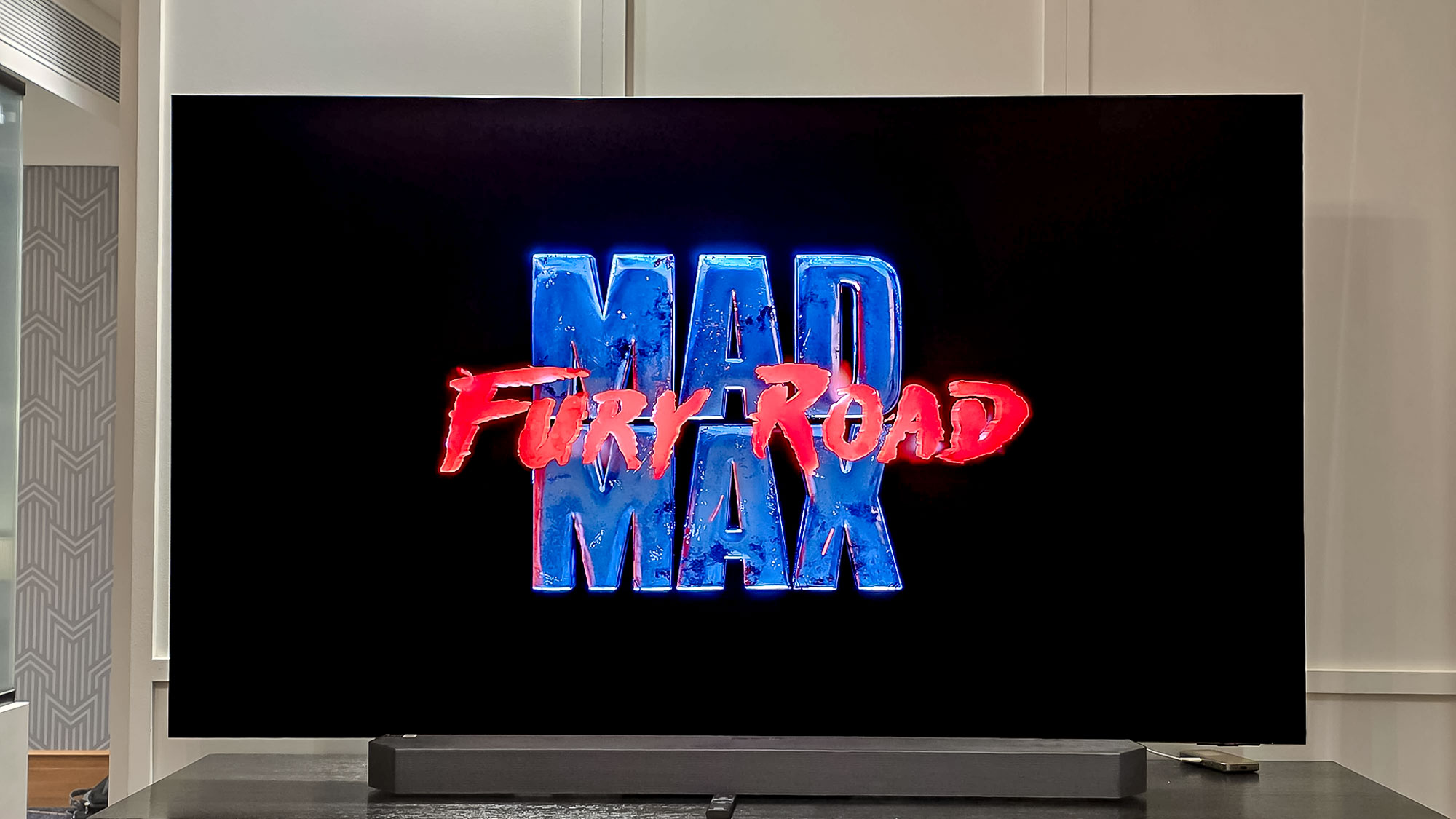
Having already seen the S95F's main OLED rivals for the year, I can honestly say that this TV is streets ahead of the competition when it comes to glare reduction.
While the bezel itself is relatively small compared to most other TVs in 2025 (we're talking around 8mm or so here, depending on where the image has shifted), there's no denying that a bezel-less TV will always look more premium by comparison.
As for the S95F's remote, it's compact, light, and keeps things simple. It's got a round directional pad for getting around menus, and anyone who's used a Samsung TV remote over the last few years will feel right at home.
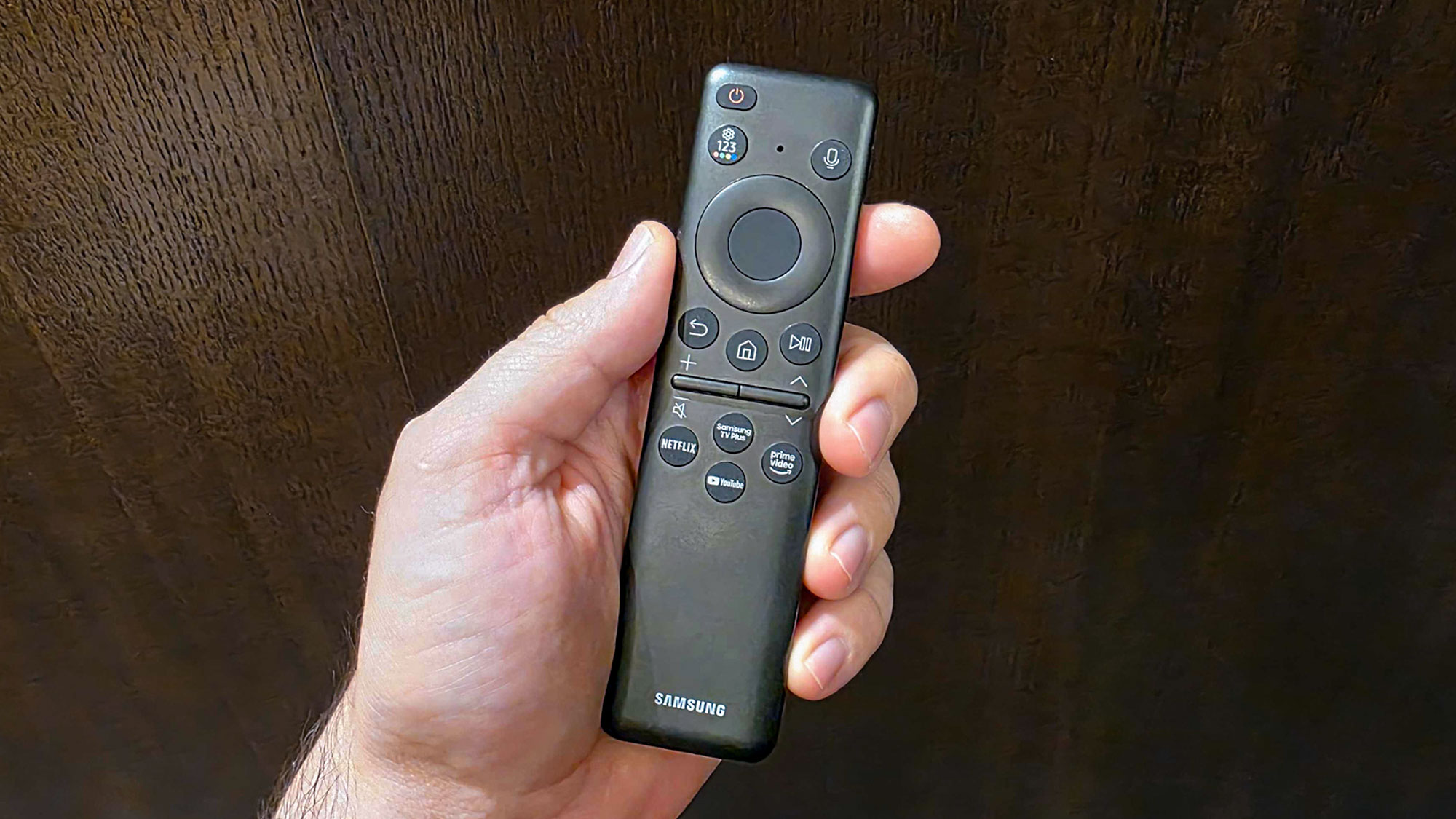
You'll also find volume and channel controls, function buttons like back, home, and play/pause, a settings button, a mic button for voice control, and a small selection of quick-launch buttons for streaming services.
Buttons for Netflix, Prime Video and Samsung TV Plus are still present. However, the dedicated Disney Plus button has been replaced by a YouTube button this time around, which, let's face it, will probably get used more frequently in the majority of households.
I'm also pleased to report that Samsung's solar-charged remote has returned with the S95F. Simply place the remote face down when not in use, and the light in your home (both natural and artificial) will help keep its battery topped up. And, if the remote's battery does eventually get low, you can quickly charge it via its USB-C port.
Samsung S95F OLED TV review: Ports
All of the S95F's ports are located on the aforementioned One Connect Box, with the exception of the port which connects said box to the panel itself.
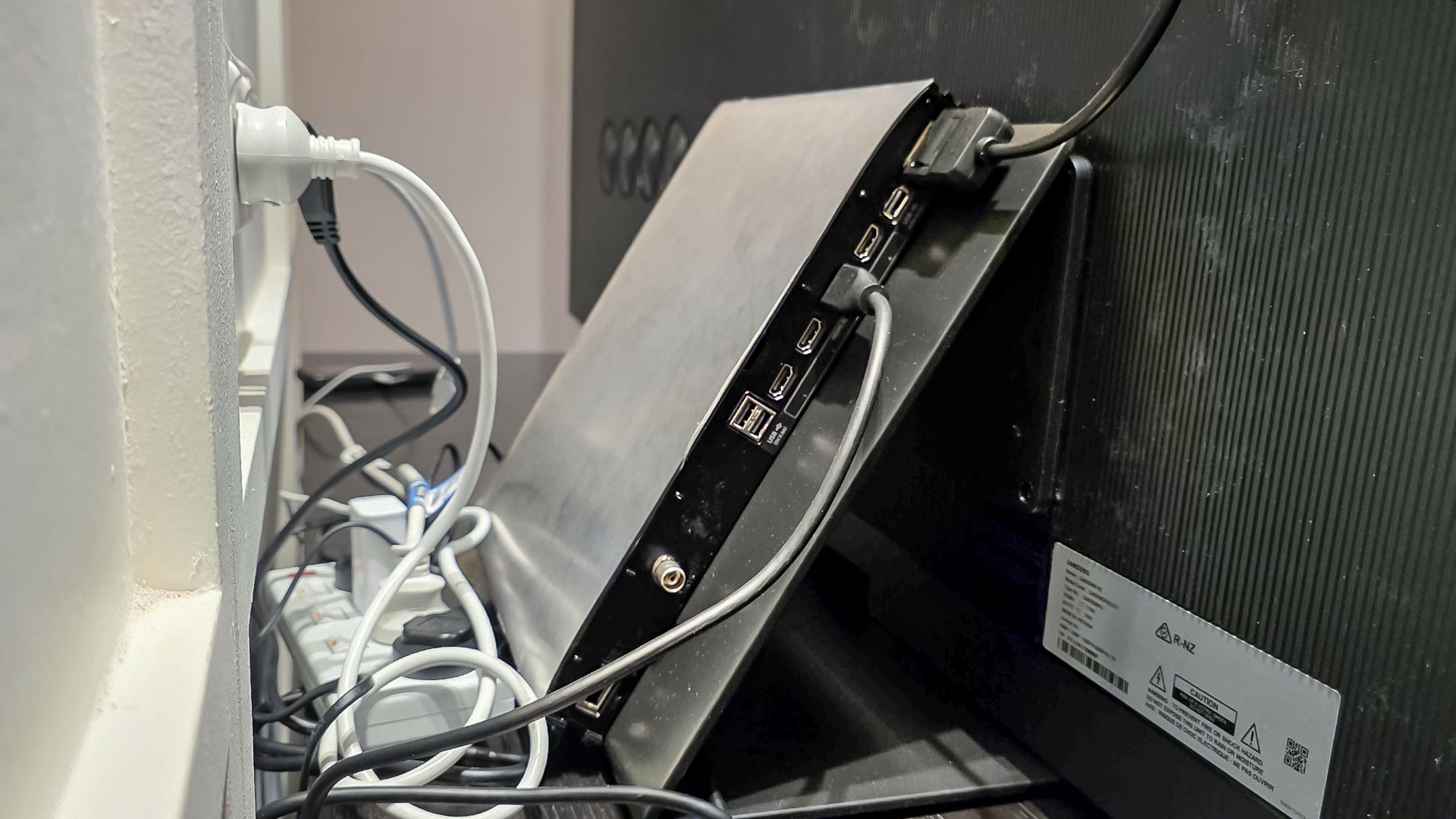
The panel receives both power and data through a single cable, which is available in two lengths: a short one for use when the One Connect Box is attached to the TV stand and a longer 5-meter cable for when the box is placed in a nearby cabinet or entertainment unit. It's worth noting that the included cable is not rated for in-wall installation and should only be used for surface running.
The One Connect Box contains four HDMI 2.1 ports (one of which supports eARC) capable of a maximum input rate of 165Hz at 4K resolution, which should be more than sufficient for most gamers on PC or console.
It also boasts three USB-A ports, one USC-C port, one ethernet (LAN) port, one digital audio out (Optical) port and an RF input for your TV antenna.
Samsung S95F OLED TV review: How we test
At Tom's Guide, we follow a standard testing protocol for every TV we review. Our benchmarks include technical and subjective tests designed to rate the set’s performance.
For our technical tests, we use a Jeti spectraval 1501-HiRes spectroradiometer, a Klein K10-A colorimeter, a Murideo 8K-SIX-G Metal pattern generator, and Portrait Displays’ Calman TV-calibration software to take measurements. We also use a Leo Bodnar 4K Input Lag Tester for determining the TV’s gaming prowess.
Subjective tests vary based on the reviewer, but usually feature anecdotes from a diverse selection of movies, TV shows, and other content reflecting the types of things you may actually want to watch on the TV. For a more detailed look at what we do and how we do it, check out our “How we test TVs” page.
Samsung S95F OLED TV review: Performance and test results
When Samsung returned to OLED TV technology after a nearly decade-long hiatus in 2022, it did so with the intention of delivering brighter OLED displays than the current industry standard. That's once again the case with the S95F, which is one of the brightest OLED TVs you can buy this year.
Testing on the S95F revealed a peak HDR luminance of 2,138 nits in a 10% window, which is fantastic for an OLED display. To put that into perspective, Samsung's Mini LED-sporting QN900D reached 2,338 in the same test, and that's one of 2024's brightest televisions. And while we haven't had the chance to test LG's 2025 flagship, the G5 OLED, the S95F's peak brightness result is well ahead of the 1,488 nits achieved by last year's LG G4 OLED.
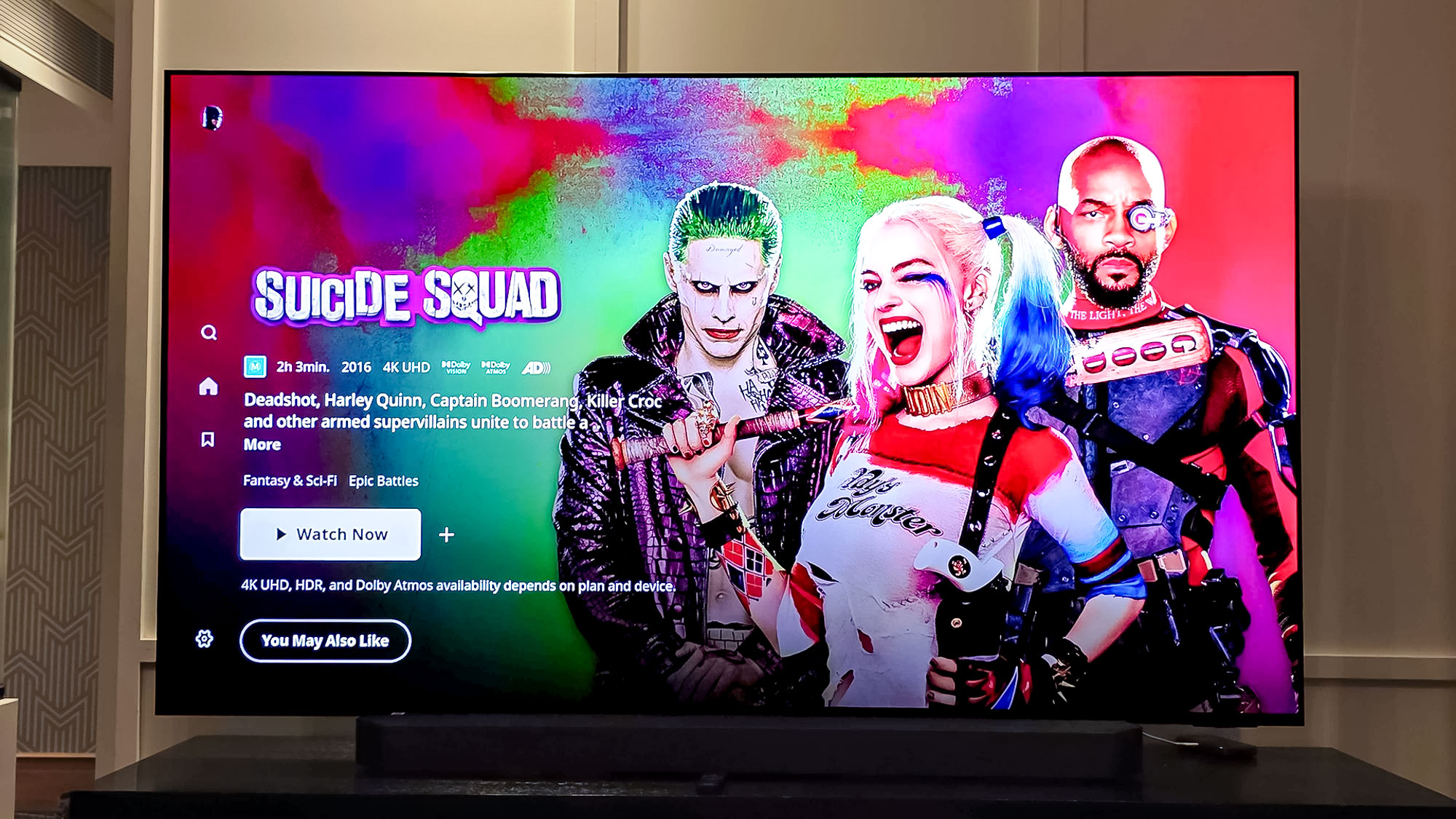
Samsung's S95F also exhibits the best color accuracy of any television we've tested to date. In the all-important Delta-E test, which is used to determine color error and where lower scores are favored, the TV measured just 1.1972.
Taking into account that last year's S95D measured 3.5085 in our own independent tests, it goes to show how much this year's model has improved — especially when many consider a Delta-E of 3 to be the threshold of perceptibility.
Even beyond its predecessor, the S95F measured below last year's LG G4 (1.4041) and this year's LG C5 (1.2468), which is an impressive feat.

The big selling point for Samsung's S95F is that it makes use of the company's Vision AI technology, and while that may be used to personalize the UI experience, the biggest benefit for most people will be its upscaling capabilities.
To put the S95F through its paces, I watched portions of several films ranging from quite old (1959's "Rio Bravo") to quite new (2024's "The Fall Guy"), along with several other movies in between using the AI mode picture setting.
Apart from everything looking as clean as can be expected based on the quality of its source (don't expect grain to completely disappear), the S95F's AI upscaling performed exceptionally in terms of image processing, with nary a hiccup spotted.

As you'd expect from an OLED, contrast is remarkable on the S95F, right down the individual pixel. During sections of Stanley Kubrick's "2001: A Space Odyssey", I was able to distinguish all the individual stars with ease against the deep black of space, though what impressed me most was how bright the Earth and other lit elements looked by comparison.
The AI mode picture settings, like the UI, can be tailored to the user's liking through a series of screens and button presses. Users begin by selecting the scene type they want to customize (sports event, movie, or general). The user will then be presented with visual options to help them find their ideal brightness, contrast, color and color tone settings, with four options to choose from for each setting.
Although this makes it effortless for users to find the most visually appealing image, with vibrant colors and deep contrast that pops, it also makes it very easy to deviate significantly from the creator's original artistic vision.
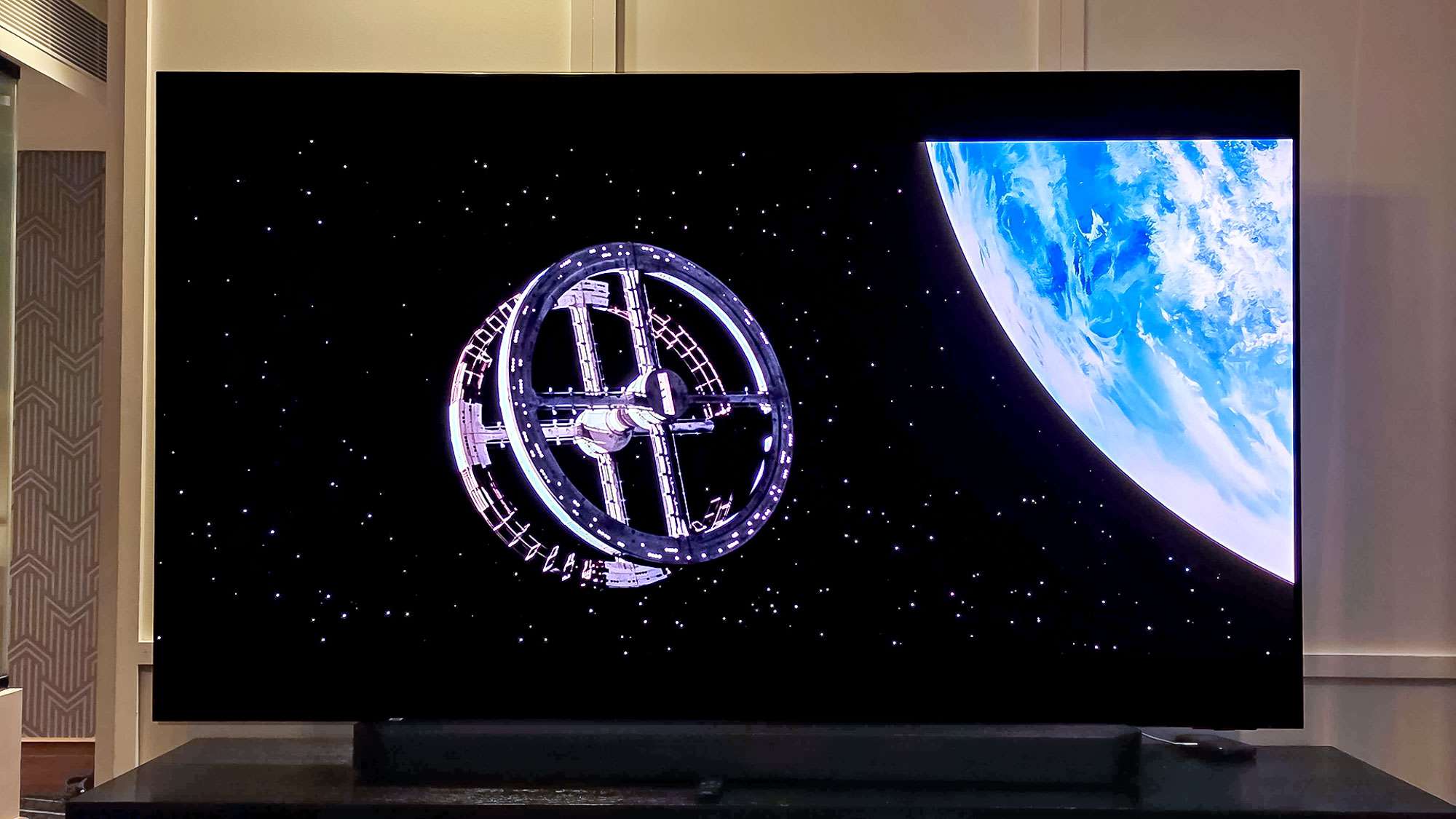
It might not seem like a huge difference at first, but when you switch between your customized AI settings and the TV's own Filmmaker or Movie modes, you'll quickly see how drastic the changes can be.
That's not to say that Filmmaker Mode is great by default — on the S95F, it's a bit too dark with a color tone that's unnaturally cool, which is far from ideal.
Thankfully, Smart Calibration is still available for those with a compatible Samsung Galaxy or iPhone device using Samsung's SmartThings app, allowing users to automatically find the TV's ideal white balance and color gamut settings to a near-professional level within minutes.
That said, it's disappointing that Samsung still refuses to support Dolby Vision 12-bit color, opting instead to implement its own HDR10+ format, preventing the S95F from displaying the full dynamic range of many titles.
Samsung S95F OLED TV review: Audio
Just like with last year’s S95D, the S95F offers a 70W 4.2.2 built-in speaker system that’s capable of decently loud, high-quality audio with clear dialogue — the latter of which can be attributed to Samsung’s Active Voice Amplifier Pro technology, which uses AI to upscale voices.
While the TV’s Dolby Atmos support, Object Tracking Sound+ (OTS+) technology and built-in height channels are supposed to bring some dimensionality to the soundstage, the effect was only slightly convincing, which means you’ll probably want to pick up one of the best soundbars to get the most immersive audio experience.
If you decide to purchase a soundbar, you may want to consider a model that supports Samsung's Q-Symphony technology, which allows the TV's speakers to work in conjunction with the soundbar for better audio and even clearer dialogue.
Samsung S95F OLED TV review: Gaming
From a gaming standpoint, the S95F comes well-equipped for both console and PC gamers alike.
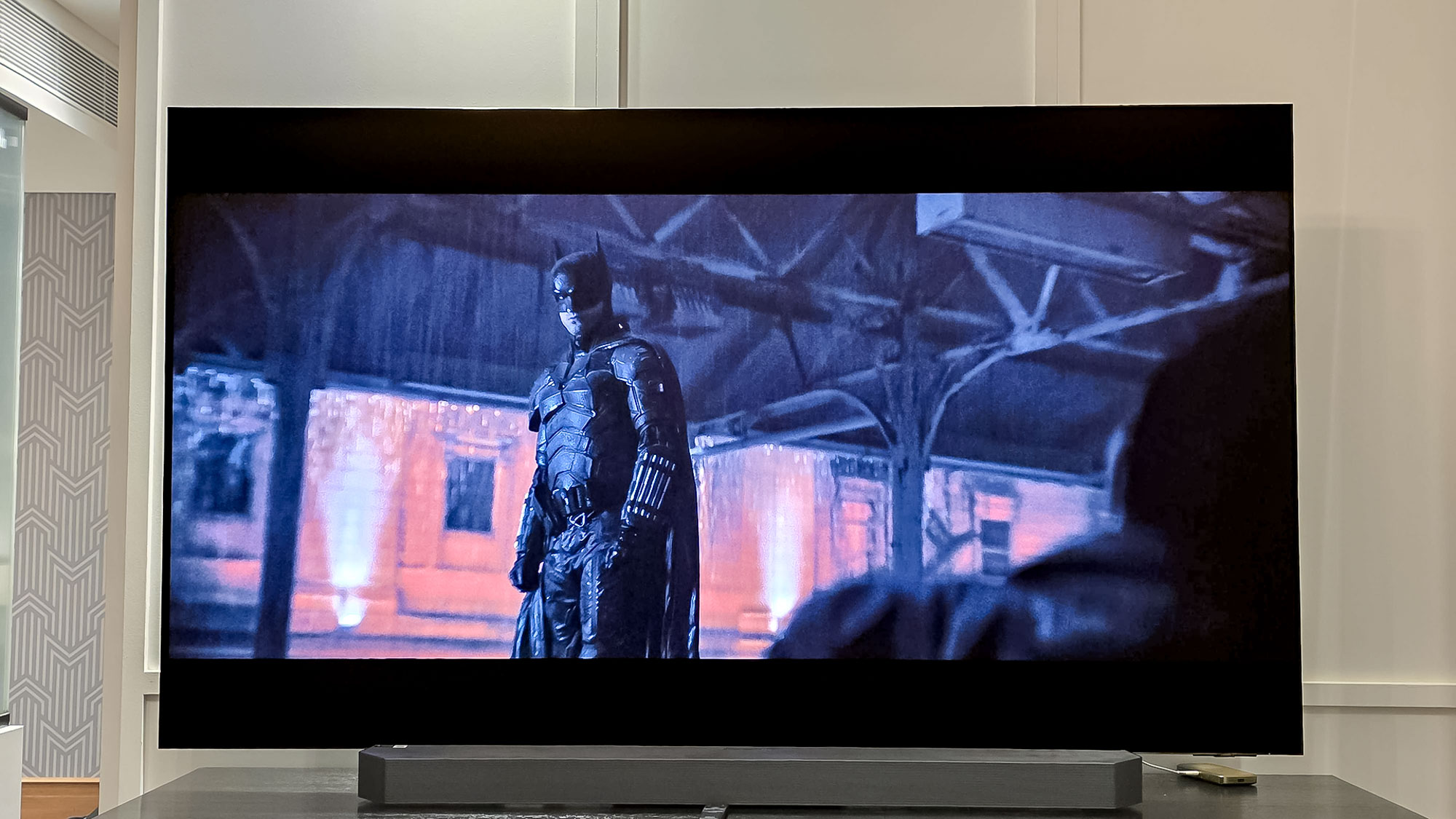
As mentioned earlier, the S95F boasts HDMI 2.1 support on all four of its HDMI ports, meaning each one can achieve 165Hz at 4K resolution, which is sure to please those looking to hook a high-end gaming machine up to a large OLED screen. FreeSync Premium Pro support returns to minimize screen tearing, as does Auto Low Latency Mode (ALLM).
Given that AI is such a large focus for Samsung this year, you probably won't be surprised to learn that the S95F sports an AI Auto Game Mode, which will automatically detect your game genre and adjust your picture settings to best suit it. Of course, you can still manually tweak these settings in the S95F's Game Bar UI, which can be reached by holding down the 'play' button on the TV's remote.
The S95F measured just 9.5ms of input lag in Game Mode — an imperceptible decrease from last year's S95D, which recorded an input lag of 9.2ms. Although we haven't tested LG's G5 flagship, the mid-range LG C5 measured an input lag of 12.9ms.
Samsung S95F OLED TV review: Smart features
Samsung's Tizen smart TV platform continues to offer one of the most cluttered interfaces on any television, with way too much to sort through when you press the home button on your remote.
I can see that Samsung's heart is in the right place as it tries to enable content discovery, but sometimes you just want a simple list of apps or devices. Instead, the home screen is split into three tabs: Discover (content suggestions), Live (currently streaming content from Samsung TV Plus channels), and Apps (recommended apps).
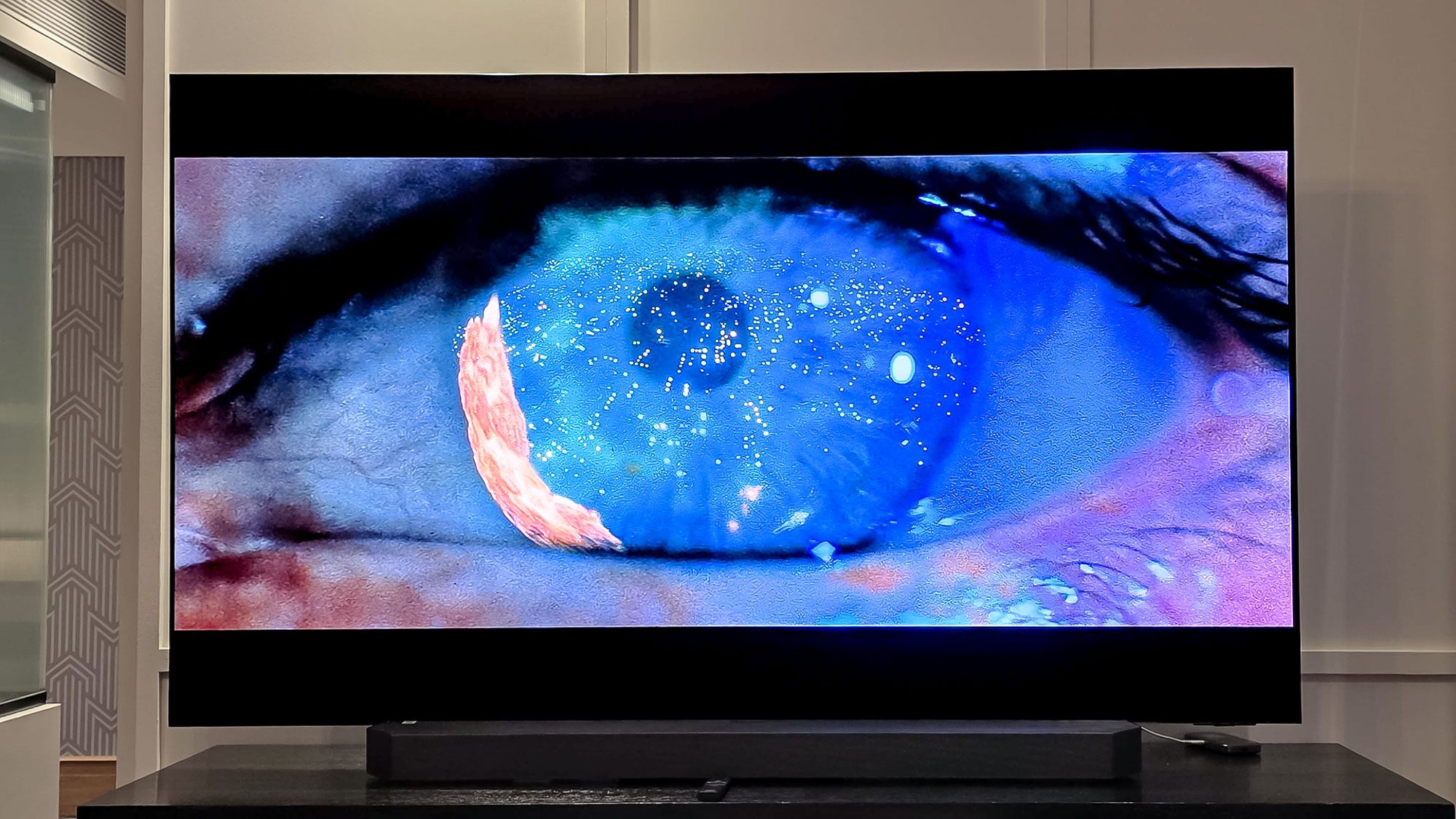
For reasons unbeknownst to me, all of your apps and content sources can be found under the 'Discover' tab. Of course, moving too quickly on the home screen will have you jumping between the three main tabs instead of cycling through your apps, which can lead to some backtracking (and frustration).
First up on the 'Discover' screen is a 'Recent' content row that shows your last used apps or content sources, followed finally by a row which lists all of your installed apps and connected devices.
Below that, you'll find endless rows of content suggestions from your installed apps, beginning with YouTube. Strangely, these YouTube video recommendations are not based on your accounts or viewing history, so you'll be bombarded with the anguished faces of all the annoying YouTube celebrities you usually try to avoid.
Thankfully, Samsung has made some UI refinements in other areas since last year. For instance, the S95F's settings now appear via smaller, floating windows on the left side of the screen, giving users a better view of their content while making adjustments.
Samsung S95F OLED TV review: Verdict
I'm ready to declare Samsung's S95F as the company's best OLED TV yet, thanks in large part to a significant increase in brightness and an outstanding glare-free display. It also boasts advanced AI upscaling features, unrivalled color accuracy and brilliant black levels. Additionally, it's an awesome TV for gamers, with support for 165Hz at 4K resolution via each of its four HDMI 2.1 ports, along with several other game-specific features.
I won't say that the S95F's AI-powered image enhancement and color tweaking is necessarily for me, but I can absolutely appreciate that many users will love how easy it is to make content look spectacular. Thankfully, it's just as easy to switch to Movie or Filmmaker Mode or run through the Smart Calibration process for a more faithful viewing experience.
Aside from the continued omission of Dolby Vision support and an unnecessarily cluttered home screen, there's not much I'd change about the Samsung's S95F OLED TV...except for maybe the price tag (Black Friday can't come soon enough).
However, it's hard to imagine anyone feeling shortchanged by what is easily one of the most exceptional OLED TVs available this year.







